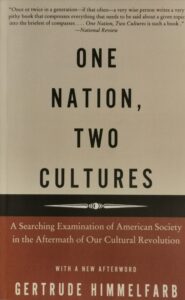An Accomplished Revolution
On the Proposal That the Culture Is Not Collapsing, It Is Gone | Part 2
Occasionally someone takes the position that the cultural revolution has happened, but even then we miss that message and take away some other thing.
People who know Gertrude Himmelfarb’s 1999 book One Nation, Two Cultures seem to remember only the title, not the subtitle – which is, “A Searching Examination of American Society in the Aftermath of Our Cultural Revolution”.

Himmelfarb says revolution not rebellion, and she did not mean a revolution incubating or getting underway or even in full swing but a revolution accomplished, since we are living in the “aftermath”. Of course we might flatly reject this proposal because we have already dismissed her use of the word ‘revolution’, since revolutions involve blood, shed in battle, and no actual warfare has occurred, but nothing in the word revolution ties it to such means. Bloodshed is simply common. A bloodless revolution will still be a revolution.
Himmelfarb, however, took a very qualified view of the notion of revolution.
Because I myself am leery of the idea of revolution, I have taken special pains to document this one by the hardest kind of evidence, quantified data.
Gertrude Himmelfarb, One Nation, Two Cultures
(New York: Vintage Books, 1999), xi
(Her chapters address “diseases of democracy”, the demise of virtue, the family, law, religion, and ethics.) She stood by her claim, that Americans of her generation have
lived through … a revolution in the manners, morals, and mores of society … [that has] bequeathed to us, in this postrevolutionary period, a society fragmented and polarized,…. [p. x]
Twenty years later we suspect that more has happened than division and polarization. To sum up the revolution like that is surely to show some kind of reticence toward the notion of revolution itself. In her conclusion Himmelfarb noted that
the two cultures are living together with some degree of tension and dissension but without civil strife or anarchy. [p. 146]
That, however, is not the usual aftermath of a revolution.
[]
In a revolution of every ordinary sort an established order is overthrown, and if this is a cultural revolution then its point or its achievement is overthrow of an established culture. Think for example of the demise of pagan society in the fourth century: the death of the Roman gods announced by (but of course brought about by) an emerging Christian culture, with the aid of imperial power.
The overthrow of a culture involves
- the ‘taking-away-of’ one of these cultures or ways of life, plucked from the hands of its adherents;
- the replacement of that culture’s means of cultivating the goods it had elected to foster, replaced with some other form of activity, ordered to quite different goods – and, as one means of achieving this,
- a change of personnel in the pivotal cultivating institutions: institutions thus removed from old-regime control, so as to reduce the old kind of production to a minimum as a new production ramps up.
All of this has already happened in our world; we will survey the evidence. This is the state of things today, as it was the state of things at the end of the fourth century.
Today there are indeed ‘two cultures’ in the sense of two scripts for living, but to be excited by Himmelfarb’s classifying ennoblement of conservative ways as a culture, with an historical pedigree – to read what she wrote in that way – is to betray a sign that your culture has already been pried away from you, as those who really belong to a culture are not encouraged by endorsements. Endorsements are meaningless; there is no one to offer a defense of our culture to. We have nothing to gain from convincing those outside the culture, as these people are not its judges, and those within the culture do not need convincing.
To read Himmelfarb as underlining the integrity of traditional culture, instead of offering a thesis about history (the emergence of a contrary and rival culture), is also to miss the thrust of the event named in her subtitle. Is it not a good reading of the evidence available to us today to suggest that the implementation of one of those scripts has been blocked – so there are not two cultures in the active sense, which is the only sense in which a culture amounts to anything. (When all that was left to the pagans of the Roman empire was the practice of pagan worship in private – indeed, in secret – paganism was on the verge of extinction.)
Himmelfarb’s claim that in the United States “two cultures are living together” – the “one nation” holds two distinct kinds of American with opposed conceptions of the good – did not entail that both were thriving; on the contrary, the very title of her book suggests (if we take the term revolution seriously) that one has been overthrown.
Himmelfarb, however, does not draw this conclusion. Her primary concern was to mark the division within America between those two ways of life, with the intent, she said, to
reject the ‘one nation’ image. [p.147]
– What did she mean by this? That America is not one thing? That there are actually two Americas? – It was not her project to answer this, but she certainly meant that that particular one-nation account of American history that sees ‘Americans’ as progressives making ever greater strides for freedom and equity – marking those who will not progress as ‘deplorably’ unAmerican – is false, because the fact of different answers, given by citizens, to questions even deeper than this generated an altogether different framing of that issue.
When opposed answers are given to ultimate questions – specifically, the traditional ‘Western’ answer and a pointed repudiation of that answer – these positions give rise to two diametrically opposed conceptions of American life.
Himmelfarb’s title – One Nation, Two Cultures – suggests, to me, One suit of clothes, two different people trying to wear them. And this cannot be done. Someone is in the clothes and the other is not.
[]
Himmelfarb focused on the division named in her title, but it seems important now to devote equal attention to the evidence for her subtitle, which reports that there has been a “cultural revolution”. If that is the case then we are living in the “aftermath” of more than a difference of vision – this is the aftermath of the engineered collapse of a once prevailing culture.
Part 3 coming on 2 January



